China - the journey continues

Summary
The strong rally in Chinese equities this year has been driven by a combination of domestic economic recovery post COVID-19 and strong liquidity with the return of ‘’animal spirits’’ among onshore retail investors. While the rally may have gone a little too far too fast, and some consolidation would be healthy, we see this as a very different situation to the boom-and-bust experience in China A-shares in 2015.
Key takeaways
|
USD total returns year-to-date are 21% and 15% for the MSCI China A Shares Onshore and MSCI China Indexes, as of 15 July 20201.
Such positive returns seemed extremely unlikely when China’s economy went into almost total lockdown during Chinese New Year in response to the coronavirus outbreak.
It is also notable that China equities have not only outperformed major equity markets around the world, they have also experienced much lower volatility. The S&P 500, for example, has experienced 10 trading days with more than +/- 5% daily movement year-to-date, compared to just two days for MSCI China A Onshore Index2.
This update is designed to explain the recent market dynamics and also to share our views on the period ahead. While we believe there will be some ‘’speed bumps’’ in the coming months, we maintain our long term constructive view on the outlook for China equities. We continue to expect that China will increasingly be viewed as a distinct asset class by global investors.
Chart 1: global equity markets relative performance YTD 2020

Source: Refinitiv DataStream, Allianz Global Investors, as of 15 July 2020. Past performance is not indicative of future results.
China - a visible economic recovery trend
Fundamentally, China has been “first-in and first-out” of the COVID-19 outbreak. The number of new daily confirmed cases in mainland China reached its peak in mid-February, and has been on a declining trend since. The effective containment of a second-wave outbreak in Beijing in June also demonstrated China’s preparedness and ability to manage the situation in a way that minimises economic disruption.
The result has been a gradual lifting of nationwide lockdowns and a visible recovery of economic activity. China’s Q2 real GDP came in well above expectations at +3.2% year-on-year, rebounding sharply from the negative Q1 reading3. Based on our interaction with companies, most listed corporates are already operating at 90% to full capacity. The exception is the service sector, where social distancing means that activities such as dining out and travelling are still at very subdued levels.
Echoing this macro response, recent corporate earnings in China have been stronger than expected. As a result, 2020 should see positive low single-digit earnings growth with a stronger rebound in 2021. While this falls short of earnings growth expectations at the turn of the year, positive growth numbers are scarce globally. The economic and earnings recovery in China appears to be well ahead of the rest of the world.
Chart 2: China economic activity by sector YTD
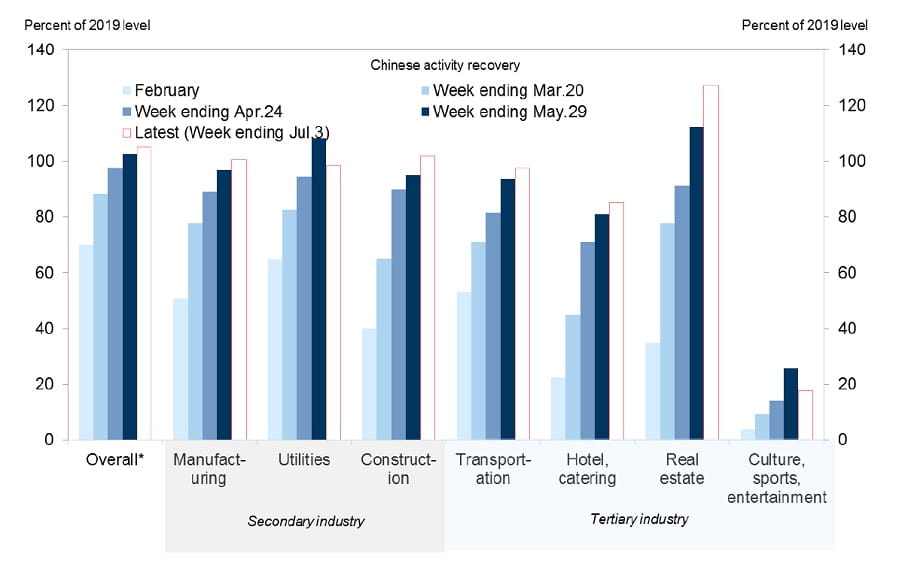
Source: Goldman Sachs, Allianz Global Investors, as of 3 July 2020.
Favorable liquidity, especially for China A-shares
It has become increasingly clear that domestic retail investors have been driving the China equity rally. Turnover in China A markets has risen to record high levels (USD 244 billion daily value traded on 14 July 20204) and a number of stocks favored by retail investors (growth, momentum names) have been leading the rally.
It is less clear what prompted this sudden surge in animal spirits. There is no one specific catalyst; instead a combination of factors have come together at the same time – including expectations of ongoing policy support, many over-subscribed mutual fund launches, and Chinese media coverage of the case for a prolonged bull market, giving the impression of a strong state ‘’put’’.
Chart 3: cumulative northbound Stock Connect flow
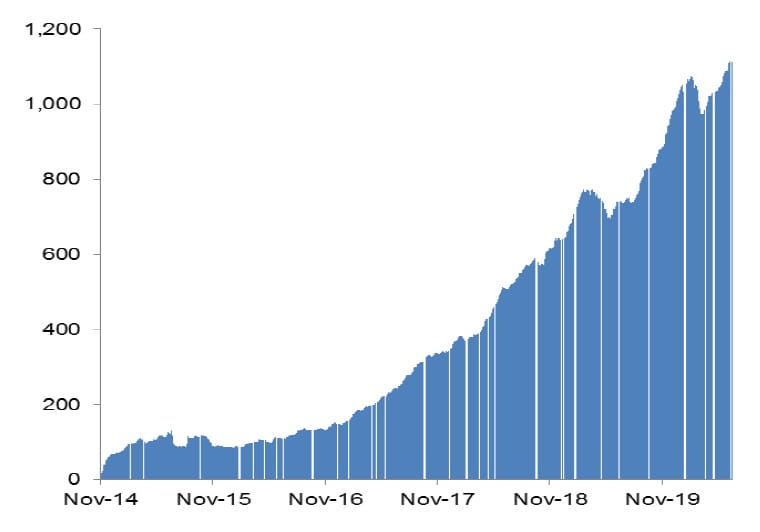
Source: Wind, Allianz Global Investors, as of 16 July 2020.
At the same time, foreign participation in China A-shares has remained strong. Year-to-date there has been USD 21 billion of northbound flows through the Stock Connect scheme purchasing China A-shares, compared to USD 15 billion during the same period last year5. In our view, the flows from international investors into China reflects a long-term asset allocation trend. Equity portfolios globally tend to be structurally underweight China relative to the size and scale of domestic Chinese markets which are increasingly accessible and therefore increasingly well-represented in global indexes. Currently the MSCI All Country World Index, for example, has a weighting of 58% in the US and only 5% in China6. The future direction of travel for these weightings seems well set and fund flows should follow.
Repeat of 2015 boom and bust unlikely
The strong market rally of recent months has understandably led to questions about the risk of a boom-and-bust scenario, similar to what happened in 2015 when China A-shares more than doubled in the space of eight months before collapsing by close to 50%7.
On the surface there are some similarities today with 2015. Margin trading was a key contributor to the 2015 market environment, and margin trading balances have again ratcheted higher this year. At the peak in 2015, margin trading balances reached RMB 2.3 trillion, accounting for 19% of daily market turnover. These numbers are currently 1.4 trillion and 10% respectively8. This has led to some “soft” warnings in the Chinese media cautioning about a repeat of a stock market crisis. If these warnings don’t work to cool the market then we should expect to see a more direct clampdown on margin financing, leading to one of the ‘’speed bumps’’ that we think are likely.
Chart 4: margin trading balance in China A-shares
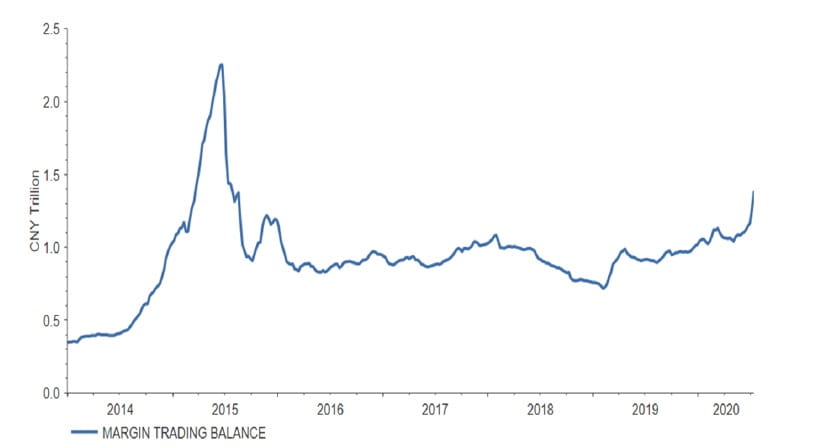
Source: Wind, Allianz Global Investors, as of 15 July 2020.
The other big market risk at the moment is geopolitics and the potential for an escalation of US-China trade tensions as we move towards the US election in November. Both candidates are vying to be seen as tough on China. And this could have unpredictable consequences for companies depending on their supply chains and the location of their customers.
In many other respects, however, the situation now is quite different to 2015. Take, for example, the tighter regulations around stock suspensions. In 2015, the market essentially froze, with a large number of companies choosing to suspend the trading of their stocks to avoid a share price free fall. Since a subsequent regulatory change, the number of suspended stocks has trended consistently lower, including during market weakness in 2018. More broadly the path of financial reform has been consistent in recent years, reflected by the MSCI decision to include - and then increase the weighting of - A-shares in key benchmarks.
In summary, the market framework for China A-shares has changed significantly in the past five years - as a result of some painful lessons. We think it is unlikely that a bubble situation will be allowed to develop again, and it is more likely that we will see some profit-taking in the coming months rather than a return to a boom-and-bust environment.
Market rally crowded, broadening of returns?
One feature of the market rally has been the concentration of returns in selective stocks and sectors perceived as high growth and thematic. For example, in the first half of 2020, only four out of the 11 sectors outperformed the broader MSCI China A Onshore Index (Chart 5). These sectors - healthcare, IT, consumer and communications - broadly represent China’s ‘’new economy’’.
Chart 5: MSCI China A Onshore H1 2020 return (USD)
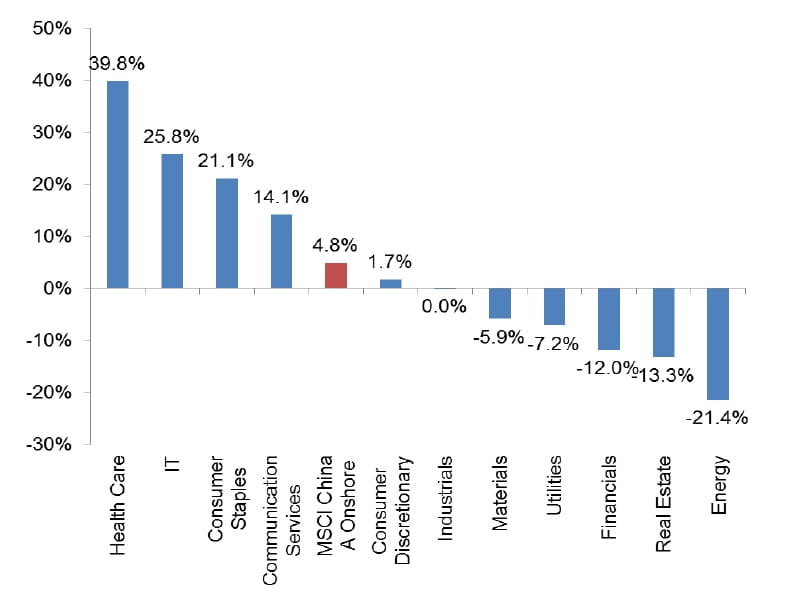
Source: Allianz Global Investors, as of 30 June 2020. Past performance is not indicative of future results.
The concentration has been so extreme that there was more than a 60% performance gap between the best performing sector (healthcare) and the worst-performing (energy) in the first half alone. Given that China A-share markets are prone to significant sector rotation and mean reversion - a function of the underlying shareholder base - we would not be surprised to see a broadening of returns in the second half of the year.
As ever, it is extremely difficult to time the tipping point of style and sector rotations; therefore we believe maintaining a balanced approach with diverse exposure across different sectors can help to mitigate the risks of missing out on sector rallies. And, instead of looking to time sector rotation or market direction, we believe a focus on selecting stocks within each sector can be designed to help produce more consistent and repeatable returns over the long term.
China — the journey continues
Looking beyond the coronavirus and its economic impact, we are still at the relatively early stages of a long-term journey in the development of Chinese capital markets. Both the quality and the quantity of the China equity universe is continuing to improve; unlike the rest of the world where many equity markets are shrinking, there have been almost 1,100 new China A company listings in the last five years9. The Hong Kong stock exchange is also transforming into a better representation of the modern-day, more digital Chinese economy.
Chart 6: Number of China A-shares listed companies
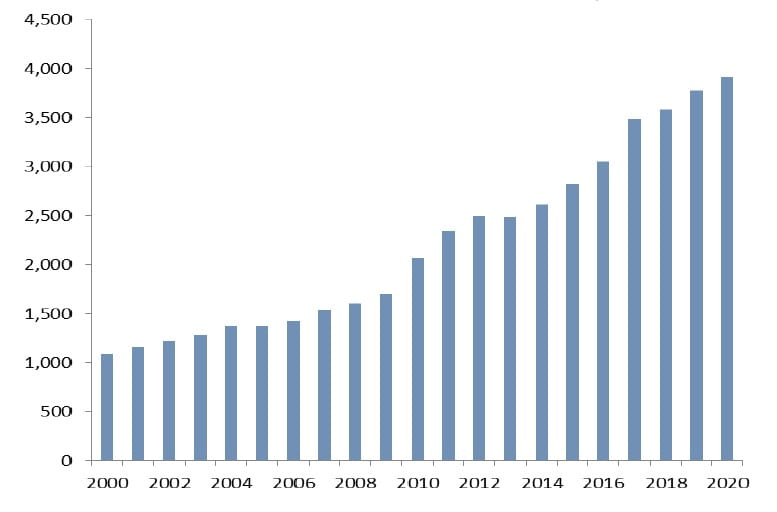
Source: Wind, Allianz Global Investors, as of 15 July 2020.
A recent notable step forward in China’s financial reform was the establishment of the Science and Technology Innovation Board (’STAR’ board) on the Shanghai Stock Exchange in June 2019. This NASDAQ-like board acts as a pilot scheme for the broader market, with a more market-oriented framework including a more flexible IPO registration process. One year since its establishment, 140 companies have listed on the STAR board, raising a total of USD 31 billion through IPOs10. The listings include companies in high tech areas including semiconductor manufacturing, artificial intelligence (AI), and biotech.
The deepening of China’s capital markets is an important step in paving the way for alternative sources of funding for innovative and strategically important domestic enterprises. This goes hand in hand with China’s strategic plan to develop domestic research and innovation capabilities.
Digitalisation and the internet of things are increasingly turning into reality in China, supported by the government’s prioritization of ’’new infrastructure’’. This covers seven key areas: 5G networks, industrial internet, inter-city transportation and inner-city rail systems, data centers, AI, ultra-high voltage, and new energy vehicle charging stations. It is estimated that cumulative investment into these projects could amount to RMB 15 trillion (US$ 2.1 trillion) over the next five years. (Chart 7)
As the government seeks to provide economic support, ‘’new infrastructure’’ has become a recent buzzword in China. However, the long-term economic implications could be profound, especially in China’s industrial sector. Equipment is becoming more digital and connected, forming networks of machines and new ecosystems, and is likely to transform China’s manufacturing industries and infrastructure facilities.
For equity investors, the trend of ‘’import substitution’’ whereby Chinese companies gain market share from foreign competitors - has been in place for several years.
Chart 7: Annual investment in “new infrastructure”
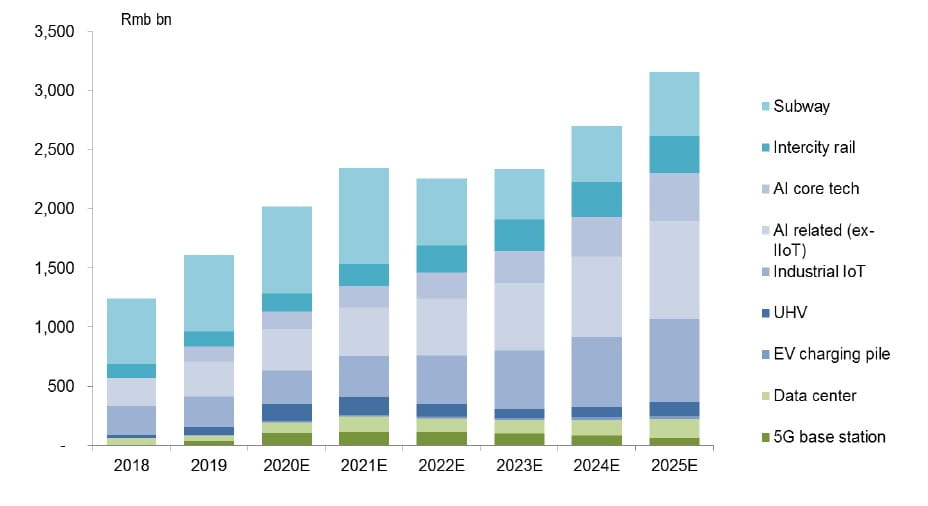
Source: Goldman Sachs, as of July 2020.
The new infrastructure focus is likely to sustain this. Looking ahead, companies with strong R&D capabilities, economies of scale, and the ability to integrate automation and data analytics across supply chains, should be well positioned for growth.
Conclusion
The strong rally in Chinese equities this year has been driven by a combination of domestic economic recovery post COVID-19 and strong liquidity with the return of ‘’animal spirits’’ among onshore retail investors. While the rally may have gone a little too far too fast, and some consolidation would be healthy, we see this as a very different situation to the boom-and-bust experience in China A-shares in 2015.
Overall, given the positive liquidity environment, supportive government policy, and the long term need for foreign investors to increase their China exposure, we remain constructive on the long-term outlook for China Ashares.
Indeed, over the long-term, we are convinced that Chinese equity markets should continue to improve in terms of the quantity and quality of investment opportunities, thanks to the continuous efforts to develop more institutional and transparent capital markets.
This should, in turn, facilitate the development of domestic innovation, especially for companies related to the “new infrastructure” space. The buildout of the next generation of infrastructure should not only help relieve short-term economic pain, but also lay the foundation of a fundamental transformation of China’s manufacturing supply chain and the competitiveness of many Chinese corporates.
1/2 Source: Refinitiv DataStream, as of 15 July 2020
3 Source: National Bureau of Statistics, as of 30 June 2020
4 Source: Wind, as of 14 July 2020
5 Source: Wind, as of 21 July 2020
6 Source: MSCI, as of 30 June 2020
7 Source: Refinitiv DataStream, as of 21 July 2020
8 Source: Bank of America Merrill Lynch, as of 21 July 2020
9 Source: Wind, as of 30 June 2020
10 Source: Wind, as of 22 July 2020
The MSCI China A Onshore Index captures large and mid cap representation across China securities listed on the Shanghai and Shenzhen exchanges. MSCI China Index aims to represent the performance of large- and mid-cap segments with H shares, B shares, red chips, P chips and foreign listings (e.g., ADRs) of Chinese stocks. The MSCI Emerging Markets Index captures large and mid cap representation across 26 Emerging Markets (EM) countries. The MSCI Europe Index captures large and mid cap representation across 15 Developed Markets (DM) countries in Europe. S&P 500 Index measures the stock performance of 500 large companies listed on stock exchanges in the United States.
Spotlight series: 5 principles for a successful China investment strategy
#5 Our research shows a small shift into A‑shares may help improve risk/return profiles













